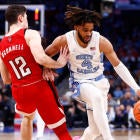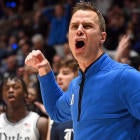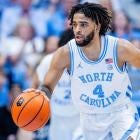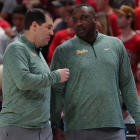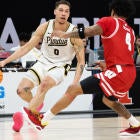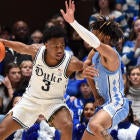In a season of upheaval across basketball that featured unforeseen squads such as Baylor, Dayton, San Diego State cementing themselves as top-10 teams, there were also dozens of unexpected stars. Featured here are 15 of them selected from major conferences and other top schools who made noteworthy strides in their games in 2019-20.
Freshmen, seniors and players who have declared for the 2020 NBA Draft were not considered. The following list of breakout players are, at present, expected to be back in college basketball playing for the same team they played for this season.
Buddy Boeheim | Syracuse
Boeheim proved as a freshman in the 2018-19 season that his place on the Syracuse roster was more than a token family favor as he made 35.3% of his 3-pointers in a steady reserve role. But Boeheim took his game to the next level as a sophomore as he complimented Syracuse star Elijah Hughes by averaging 15.3 points per game. Best about Boeheim's sophomore surge is that he increased his 3-point shooting to 37% even while averaging 8.2 attempts per game. With Hughes declaring for the NBA Draft, even more will be expected from Boeheim as a junior. But as a player who was ranked No. 349 by 247Sports in the 2018 class, he's already exceeded expectations while playing under his father.
Garrison Brooks | North Carolina
It's jarring to consider where the Tar Heels may have been this season without the quantum leap Brooks made as a junior. He was a starter as a sophomore but but just a role player for a 29-win Tar Heels squad featuring first-round draft picks Coby White, Cameron Johnson and Nassir Little. But as UNC dealt with injuries and unmet expectations this season, Brooks emerged as a bright spot by averaging 16.8 points and 8.5 rebounds per game. His veteran presence and production and the arrival of the nation's No. 3 recruiting class should be enough to get UNC back to the NCAA Tournament.
Garrison Brooks is our Most Improved Player!
— ACC Men's Basketball (@accmbb) March 9, 2020
Averaging 16.4 ppg, @__garro has more than doubled his scoring average from a season ago 👏
🎥↓ pic.twitter.com/oU0R14dqxK
David Duke | Providence
Providence improved dramatically in the 2019-20 season, and so did Duke. Making the jump from 7.1 points per game as a freshman to 12.0 per game as a sophomore was significant. But the uptick in efficiency from 29.7% 3-point shooting to 42% while increasing his number of attempts per game is what made him one of the Big East's top breakout players expected to return for another season. Duke also doubled his number of steals per game and held his number of turnovers steady, even while playing more minutes per game and having the ball in his hands more often as a focal point of the Friars' offense. With leading scorer Alpha Diallo graduating, look for Duke to make another jump offensively next season while also drawing more challenging defensive assignments.
John Fulkerson | Tennessee
With Grant Williams and Kyle Alexander departed, Fulkerson finally got to build on the promise he showed in 10 games as a freshman in the 2016-17 season before injuries derailed a promising beginning to the 6-foot-9 forward's career. As a redshirt junior this season, Fulkerson averaged 13.7 points on 61.3% shooting as he became the centerpiece of Tennessee's offense. The lanky left-hander averaged 16.6 points per game over the final 15 games of the season. For a reserve who scored 3.1 points in 12 minutes per game the season before, it was a great reward for his perseverance through injuries and two seasons of playing a lesser role than the one he initially seemed destined for. If Fulkerson can improve his right-handed finishing ability and add a perimeter jumper, he could be a dark horse candidate for SEC Player of the Year next season.
John Fulkerson
— Derek Murray (@dmurrayNBA) March 4, 2020
6-9 F Tennessee@fulkerson_john had a huge performance last night, leading the Vols to a W in Lexington. With 27 PTS + 6 REB + 2 AST, he continues to be one of the best players in the SEC.
PnR Roll: 92nd percentile
Post up: 87th
Transition: 99th@ProBBallCombine pic.twitter.com/yDBfv8uLP2
Ron Harper Jr. | Rutgers
Harper keyed Rutgers' historic season by leading the Scarlet Knights in scoring as he transformed from a role player on a mediocre team in 2018-19 into a star for a team that was likely headed its first NCAA Tournament in 29 years before the season was cut short. At 6-6, 245 pounds, Harper possesses a suave shooting touch and is also capable of bruising opponents on the block. His increase in offensive production from 7.8 points as a freshman to 12.1 as a sophomore stands out, but his increase in rebounding from 3.1 per game to 5.8 while playing only six more minutes per game is arguably the biggest improvement in his game this season. Look for him to take another leap as a junior.
Keyontae Johnson | Florida
On a team loaded with youth, Johnson's steady sophomore improvement stood out. The versatile 6-5 forward averaged a team-high 14 points per game and was the Gators' second-leading rebounder at 7.1 per game. His consistency was also a welcome plus for a team that dealt with plenty of ups and downs. Johnson reached double figures in 13 of Florida's last 14 games. The former four-star prospect will be an early favorite for SEC Player of the Year next season as he could end up as the only one of nine players voted First Team All-SEC by the league's coaches to return to college.
More Keyontae Johnson goodness. Blocks Tyrese Maxey's floater then smartly cuts inside and scores at the rim pic.twitter.com/pCTwPaUNTf
— Jackson Frank (@jackfrank_jjf) April 9, 2020
Tyson Jolly | SMU
Jolly finally found his niche with SMU after redshirting as a freshman at Baylor in the 2016-17 season and playing sparingly for the Bears in 2017-18. After a season in junior college, the 6-foot-4 guard led the Mustangs in scoring at 14.5 points per game on 38.2% 3-point shooting this season while pulling down 6.2 rebounds per game. Jolly and SMU could take an even bigger step forward next season, depending on who else returns from a 2019-20 team that finished 19-11 without a single senior on the roster.
Myreon Jones | Penn State
Only an extended illness could slow Jones down as the sophomore guard missed most of February with sickness. Still, his breakout season helped Penn State to its first winning record in Big Ten play in over a decade and its first ranking in the AP Top 25 since the 1995-96 season. The 6-foot-3 Birmingham, Alabama, native averaged 13.3 points on 40.3% 3-point shooting and also contributed 3 assists and 1.3 steals per game. His productivity uptick came after a freshman season in which he played a reserve role and averaged just 4 points per game on 27.7% 3-point shooting. With three key teammates graduating, Jones is in line to be one of the Big Ten's top guards next season.
The Biggest Big 10 Ten Sleeper @MyreonJones21 20 PTS 5 AST Again On The Road Win This Time vs Michigan State @PennStateMBB pic.twitter.com/lOKTwQ9jw0
— GreenLightViews (@GreenLightViews) February 6, 2020
Filip Petrusev | Gonzaga
With the departures of Rui Hachimura and Brandon Clarke, it was obvious Petrusev would take a bigger role for Gonzaga in the 2019-20 season. Not many predicted just how big his leap would be, though. The 6-foot-11 Serbian averaged 17.5 points, up from 6.5 as a freshman as he morphed from a bench player into the star of a team that exceeded expectations while positioning itself for a No. 1 seed in the NCAA Tournament before it was cancelled. Petrusev reached double figures in 31 of 33 games and was named West Coast Conference Player of The Year while shooting 56.2% from the floor and corralling 7.9 rebounds per game.
Yves Pons | Tennessee
Finally given an opportunity to shine following Tennessee's exodus of talent, Pons proved to be a viable offensive option as a junior starter following two seasons in a limited role. But where the explosively athletic 6-6 wing starred most was on the defensive end. Pons led the SEC in blocks per game at 2.4 as he showcased the positional versatility that makes him a viable NBA prospect. If Pons can continue building on the offensive improvement he showed this season, the French prospect who played just 5.2 minutes per game as a freshman could have professional scouts drooling by the end of his senior campaign.
Yves Pons almost hit his head on the rim on his 1st of 3 blocks. Check out his put back slam too. pic.twitter.com/w2YlvdL98i
— Patrick Murray (@PatMurraySports) November 7, 2018
Will Richardson | Oregon
The improvement of now-graduated Pac-12 Player of the Year Payton Pritchard and the overhaul of the Ducks' roster through transfers and a strong freshman class made it easy to overlook the leap Richardson took as a sophomore. The former 247Sports top-50 prospect offered modest contributions of 6 points, 2.5 assists and 2.4 rebounds per game as a freshman while shooting 27.8% from 3-point range. But he took a significant leap this season to help make Oregon's backcourt one of the best in the country. Richardson averaged 11 points on 46.9% 3-point shooting, snagged 1.4 steals per game and decreased his turnovers per game while playing more minutes as a sophomore. Look for him to make another big jump as a junior.
Olivier Sarr | Wake Forest
Sarr completed his evolution into a top-flight ACC talent during a breakout junior season after starting his college career as a foul-prone prospect who struggled to convert at the rim. The 7-footer finished second behind Brooks in the voting for the ACC's Most Improved Player after averaging 13.7 points, 9 rebounds and 1.2 blocks per game as a junior while hitting a career-best 52.7% of his shots. Though his improvement did not significantly help the struggling Demon Deacons, Sarr's progress as a player is a testament to embattled Wake Forest coach Danny Manning's player development chops.
.@sarr_olivier had a breakout year in 2019-20! 🔥🔥
— Wake Basketball (@WakeMBB) March 25, 2020
Last season ➡️ this season:
FG: 47.4% ➡️ 52.7%
PPG: 6.2 ➡️ 13.7
RPG: 5.5 ➡️ 9.0
FT: 70% ➡️ 76%#GoDeacs pic.twitter.com/LDfPzHJPHt
Chris Vogt | Cincinnati
Vogt followed coach John Brannen from Northern Kentucky to Cincinnati, received a waiver to play immediately and took massive strides as a junior. After offering limited contributions in the Horizon League in his first two seasons of college basketball, Vogt morphed in to a productive starter for the Bearcats by averaging 11 points, 5.9 rebounds and 1.6 blocks per game. His 64.8% shooting percentage led the AAC. Even more will likely be expected from the 7-1 center next season after the graduation of three of Cincinnati's top five scorers and the decision of junior guard Keith Williams to enter his name for consideration in the NBA Draft.
Moses Wright | Georgia Tech
If the growth trajectory of Wright's career continues into the 2020-21 season, the ACC will be at the mercy of the Georgia Tech power forward and NBA scouts will begin taking keen interest in the former unranked prospect. Wright averaged 13 points, 7.0 rebounds and 1.1 blocks per game as a junior with a 33-point game at Syracuse and a 22-point game at North Carolina among the highlights. After making just 30.7% of his shots as a freshman, Wright hardly looked like a viable Division I player. But the late-blooming prospect got better as a sophomore and made a huge leap as a junior. If he can improve his 3-point shot as a senior, Wright could be the impetus to get the Yellow Jackets back to ACC relevance.
Marcus Zegarowski | Creighton
The 6-foot-2 point guard was good as a freshman but he developed into a great player as a sophomore this past season and could be on his way to elite status. With Creighton's leading scorer Ty-Shon Alexander declaring for the NBA Draft, the stage is set for Zegarowski to parlay his breakout sophomore season into a potentially historic junior campaign. The Massachusetts native averaged 16.1 points, 5 assists and 1.1 steals per game while hitting 42.4% of his 3-pointers in the 2019-20 season. Now he'll be the unquestioned leader of the defending co-Big East champions.
Marcus Zegarowski's averages are up across the board and I think he's the breakout player in the Big East. What's led to his standout sophomore season for @BluejayMBB? pic.twitter.com/hByTeQuhfM
— Evan Daniels (@EvanDaniels) January 21, 2020















